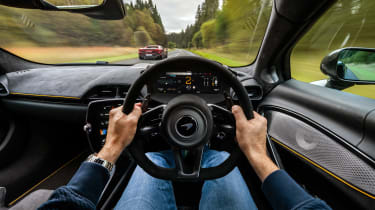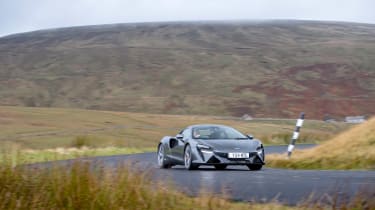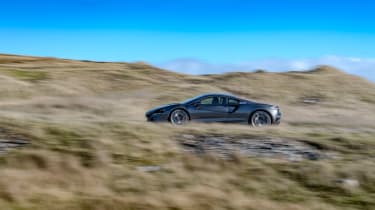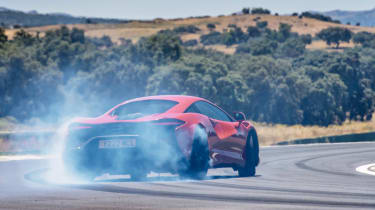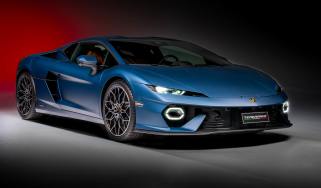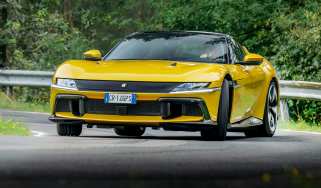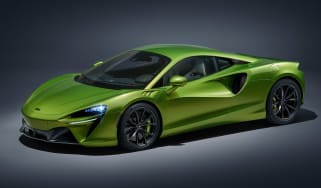McLaren Artura 2023 review – can it compete against its hybrid Ferrari 296 GTB rival?
The Artura is an impressive first chapter of McLaren's hybrid generation, but we know there's more to come
So this is it. An all-new McLaren supercar. For the first time since McLaren Automotive launched the MP4‑12C onto the supercar scene in 2010, it is presenting a new car that shares nothing with what has gone before. The twin-turbocharged M838T/M840T V8 engine and seven-speed dual-clutch transmission are gone. The new car is not built around a derivative of the MonoCell carbonfibre tub. There’s a new electrical architecture, new multi-link rear suspension and, for the first time on a modern McLaren, an electronically controlled locking differential. Moreover, this is the first series-production hybrid to come out of Woking. The start of a new chapter and absolutely critical to McLaren’s success. This is the Artura. It could scarcely be more significant.
I’d love to get straight into the dynamics of McLaren’s new supercar, but there’s so much to cover first. So let’s look at the complexities of its constituent parts, consider its positioning and, finally, find out whether it delivers on its promise of an all-new driving experience that still prioritises lightweight engineering, feedback and involvement. The styling? That you can judge for yourselves. For me there’s no denying it’s a handsome, cleanly sculpted and beautifully proportioned car, but considering the daring ambition beneath the mostly superformed aluminium skin, it’s disappointing that it could very easily be mistaken for a facelifted 570S.
For now, forget everything you know about modern McLaren. The Sports Series/Super Series/Ultimate Series structure to the range is finished. Instead there will be three new pillars: GT, Supercar and Ultimate (okay, that one stays the same). The Artura, priced from £189,200, will live with the 720S and 765LT in the Supercar section, slotting beneath them despite having quite a lot more tech and all the next-gen goodness.
This might sound like needless housekeeping but it’s crucial. Effectively, the 570S was an entry-level car and it provided a unique proposition at its circa-£150,000 price point. You simply couldn’t get a true carbon-tub supercar anywhere else for similar money and it was a huge success for McLaren. They’ve now walked away from that market. The GT – which hasn’t been a roaring success, to put it politely – is now the cheapest McLaren available, at £165,230, and the Artura is right in the mix with Maserati MC20, Lamborghini Huracán EVO and Tecnica and Ferrari 296GTB.
Take a look at the specifications and the technology of the Artura and you can see why the price had to climb. It’s built around the new McLaren Carbon Lightweight Architecture, which consists of a new carbonfibre monocoque built in-house at a new facility near Sheffield, with aluminium crash structures at the front and aluminium rear subframes plus a new electrical system that uses Ethernet cabling rather than traditional wiring looms. Great for speed and connectivity and, in theory, much more robust when dealing with large temperature swings and electromagnetic interference. Oh, and it saves lots of weight, too. This is an industry-first application of the technology.
Cradled in that rear aluminium subframe is the new ‘M630’ 3-litre twin-turbocharged V6 engine. It’s McLaren’s first direct-injection engine and features a 120-degree angle and two turbochargers nestled in the wide vee. At 160kg it’s some 50kg lighter than the V8 and 190mm shorter, too. It’s a little jewel of an engine and produces 577bhp at 7500rpm and 431lb ft from 2250 to 7000rpm, with a rev limit set at 8200rpm and the ability to go to 8500rpm intermittently.
A new eight-speed dual-clutch gearbox incorporates a new e-diff plus an axial flux e-motor (lighter, more efficient and much flatter than a radial flux motor) rated at 94bhp and 166lb ft. The e-motor sits directly on the input shaft in the bellhousing and also acts as a reverse gear. In combination, the Artura’s powertrain develops 671bhp and 530lb ft. McLaren claims a top speed of 205mph, 0-62mph in 3.0sec and 0-124mph in 8.3. A 7.4kWh battery pack is housed towards the rear of the monocoque floor and, thanks to optimised cooling, McLaren says the Artura can complete a full trackday session without any loss of performance. Ascari Race Resort waits for us up in the hills so we’ll find out later if that holds up. For now we have to get there and, naturally, we decide to take the most circuitous route possible.
Swing the door up and forwards, drop behind the steering wheel and it’s at once familiar and strangely new. The driving position is, as ever, fantastic. You sit low on the new ‘Clubsport’ seats (fixed back but the tilt angle of the entire seat is electrically adjustable), the pedal placement is perfect, and dead ahead is a simple, elegant steering wheel with not a button, switch or pimple of any sort to distract. However, the quality appears to have taken a noticeable step up, both in material choice and the crispness of the detailing.
Of more immediate note is the relocation of Handling and Powertrain controls. Previously, exploring these options required pressing a button marked ‘Active’ on the centre console and then turning two rotary switches to mix or match settings. Now there’s a rocker switch located on each side of the instrument binnacle, which floats on the adjustable steering column. They’re always active and ready. It’s possible to toggle between the four Powertrain settings of e-mode, Comfort, Sport and Track on the right-hand side and Comfort, Sport and Track on the left for Handling without your hands ever straying from the steering wheel itself. I actually liked the old ritual of waking the panel up before exploring more extreme settings, but understand this is a simpler and more practical solution.
On the move the Artura feels new immediately. And not just because it starts in e-mode, good for a range of up to 19 miles and speeds of up to 81mph. Despite using conventional continuously variable dampers, coil springs and anti-roll bars rather than the 720S-style hydraulically linked set-up that attempts to decouple ride quality and roll stiffness, the ride is excellent. No surprise, for this is a McLaren trademark. However, not only is there control and poise but it’s so much quieter than before. Previously, you could hear the bumps and lumps even if you couldn’t feel them. With the Artura even the physical work going on to smooth the surface is magicked away.
This added polish and refinement is reinforced by sensations through the steering. McLaren has stuck with hydraulic assistance but the feel of the rack is very different to what’s gone before. The weighting is too heavy for my tastes but the biggest differentiator is the way the ‘noise’ has been dialled out of the system. A 720S, for example, pours back information in its rawest form. The wheel wriggles and writhes and sometimes gets hooked into ruts or wheel-tracks and there’s an abundance of texture as the Alcantara-covered rim oscillates in your hands. Now, it’s much calmer. There’s no kickback and, while I miss the old, coarse feedback, there’s no question that you can still sense what’s happening down at ground level in the Artura. You just need to listen a little more closely.
Wake the engine by switching modes and you get to experience the next big change in the McLaren experience. The V6 is vocal enough but it’s extremely smooth and has a precise, highly tuned feel to the way it revs. With the assistance of the electric motor, there’s superb throttle response. In fact, the torque-fill is extremely effective and works much better than it did in the P1, for example. In McLaren’s fire-breathing hypercar you got the sense there wasn’t enough electric torque to fill in the holes in its 3.8-litre twin-turbocharged V8’s power curve, but here the electric motor is perfectly matched to the engine. The way the Artura is picked up and flung forwards in any gear from a few revs above tickover is stunning. And it doesn’t let up one bit before the limiter.
So, the Artura makes a pretty fantastic first impression. There’s poise, high-quality feedback and pulverising acceleration. The ’box is punchy and whilst McLaren uses the e-motor to smooth the torque interruption, there’s none of the surge employed by Ferrari in the 296 GTB. No tricks, just an intelligent deployment of the hybrid system’s capabilities. Even the portrait-orientated touchscreen seems to work, with no lag and a simple interface.
Of course, while the electric motor and battery bring enormous advantages in terms of throttle response, they inevitably bring a penalty, too. McLaren says the full hybrid system adds 130kg to the Artura’s mass and the total kerb weight to our preferred DIN standard, i.e. with fluids and 90 per cent fuel load, is 1498kg. That compares favourably with the Ferrari 296 GTB, which is 1470kg before fluids and when fitted with lightweight options. However, consider that a 720S is 1419kg DIN and you start to see that McLaren’s dedication to chasing out weight can only achieve so much.
As the roads bunch up, the weight begins to tell and pretty quickly you’ll want to add more support to the chassis by selecting Sport mode for Handling. You’ll probably click the Powertrain rocker switch right up to Track, too. I mean, why not? This is the Artura in its ultimate spec for road use. Body control is much improved but the ride remains supple and the engine is at full noise and maximum response. The system also prioritises keeping the battery in a high state of charge to ensure maximum performance is available at all times. The ‘Target’ level of charge can be tailored via a menu system in each mode.
On twisting, broiling roads the Artura is indecently fast, piling on speed so rapidly that the numbers on the speed readout become a blur. Yet despite the frantic performance and huge forces at work there’s a coolness to the way it dissects whatever’s ahead. It’s highly responsive and alert but there’s a measured feel as you peel it into turns and not a hint of nervousness. You can feel the added mass on the brakes but the Artura remains composed; in fact the whole vibe is of a car that’s operating well within itself. New multi-link rear suspension increases toe stiffness by 75 per cent and in combination with the e-diff is said to increase stability, consistency and agility. You might not feel those changes in isolation over, say, a 720S, but the way the Artura seems eerily composed certainly seems to back it up.
Over rough and indecently surfaced roads like those we so often come into contact with in the UK, the Artura only reinforces this poise and balance. There’s an ability to reach into the road surface without any real compromise in body control, while larger undulations are hoovered up with a clinical precision that can only come from exceptional, high quality chassis tuning.
This unruffled personality breeds confidence but there’s no question that some of the 570S or 600LT’s pure, uncut enthusiasm is lost to the efficiency of the process. Where the 600LT in particular displayed quite stunning balance that seemed to work all four tyres at exactly the same rate, the Artura feels slightly more conventional. It understeers first and that seems to be the car’s comfort zone until you push through and utilise the new e-diff. On slippery Spanish roads it’s actually remarkably playful and slides with real progression. Even better, the 15-stage Variable Drift Control allows experimentation and the confidence to push to a point that the rear wheels are speeding faster than the fronts.
My brain is telling me that the Artura ticks every box. Surreal performance delivered with total precision, an uncanny ability to deal with all sorts of surfaces and a broad range of suspension settings from Comfort up to Track, an indulgent chassis balance once you push beyond the initial understeer, and lovely brake feel. McLaren chose not to harvest energy from regenerative braking and it was a good move. Yet for all the talent on show, I feel impressed rather than enthralled. The engine is sweet and precise but doesn’t grow and evolve as the revs build. There’s no turbo noise and the e-motor is also silenced behind the singular, oddly synthetic exhaust note. The Artura embraces hybrid technology so convincingly but wants to hide the complexity, perhaps to the detriment of character.
It’s an understandable approach. Who wants turbocharged chirps and flutter and e-motor whine when you can have a pure, highly tuned V6 singing to the driver? But in reality the V6 isn’t exactly orchestral and the old P1 approach of creating a living, breathing, whirring, screaming monster from a hybrid powertrain seems like a piece of heritage that could and should have been happily plundered. There’s none of the frantic high-rev energy of a 720S, so why not unleash some character? Maserati has proved you can do calm, collected and unhinged in one package; Ferrari has made a V6 that actually sounds musical. The Artura can’t match either in terms of simply putting a smile on your face every time you crack the throttle.
So, it sounds restrained, the steering has lost the raw feedback of previous cars and its weighting introduces a sense of inertia. Even the balance isn’t quite as sharp. It’s a fantastically poised machine but some of the bubbling, high-energy feel and breathless agility has been allowed to escape in the name of ‘bandwidth’. I love the big steps in chassis settings between the modes, the lovely over-the-limit playfulness and accurate throttle response. Yet somehow the car feels like it’s keeping me at arm’s length. How, after finding such success with LT models that have been adored by press and buyers alike, has McLaren decided that the Artura should channel the more clinical feel of the 12C instead? Especially when the 720S shows that outrageous can very easily sit alongside useability.
This is the key issue pinballing around my brain when the red light turns to green at the end of the Ascari pitlane. Hopes are not high. If the Artura’s weight and GT-style sensibilities show up on the road, it seems highly likely it will unravel altogether on track. Within three corners my expectations are confounded. It works. Brilliantly. There’s still that slight understeer balance on turn-in, but the Artura discovers its edge. The diff hooks up superbly and gives fantastic drive out of turns, mid-corner balance is neutral and easily managed by the throttle, and the car feels so fluid and easy to control. You really can pick your line and angle of attack with confidence, precision and, if you fancy it, all the smoke, noise and drama for which you could ever wish. There’s a bit of grit now, too. In its stiffest setting the suspension hops and digs for drive out of the first fast chicane, the steering requires a firm hand over kerbs, there’s just more life in every element of the car. I couldn’t be much happier.
On both sides of the channel, the Artura has proven that despite its delayed execution, has indeed been worth the wait. But we can’t help but think (and suspect) that this is just the bottom rung on a ladder that will continue to rise upwards. In our 2022 evo Car of the Year test, Artura tied with its key rival, the Ferrari 296 GTB, in third place – an excellent showing both for the brand and for the future plot of the hybrid performance car. We all can’t help but wonder whether the next rung might unleash a little more of the rabid character that made the eCoty-winning 720S and 600LT so ultimately brilliant.
Prices and rivals
The Artura might theoretically replace the previous Sport Series models, but its extra power and tech sees it priced much higher than what used to be considered an entry-level supercar. At £189,200, it’s now priced in the thickest part of the supercar market, with Lamborghini Hurácan, Maserati MC20 and Ferrari 296 GTB all considered direct rivals.
It’s only the Ferrari that competes with a hybrid powertrain, though, but does come at a much higher price tag of over £240,000. As ascertained during eCoty 2022, the Artura has the legs on its Italian rival when it comes to ultimate poise, engagement and feel, but lags with a more humdrum powertrain and a less expressive personality right at the top of its operating window.
Specs
| Engine | 2993cc, twin-turbo, plus axial flux e-motor |
| Power | 671bhp (combined) @ 7500rpm |
| Torque | 530lb ft @ 2250-7000rpm |
| Weight | 1498kg |
| Power-to-weight | 455bhp/ton |
| 0-62 | 3.0sec |
| Top speed | 205mph |
| Basic price | £189,200 |


